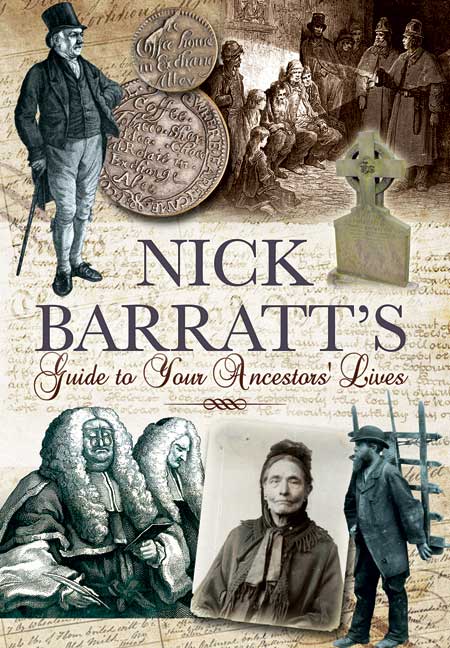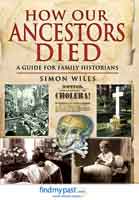Nick Barratt's Guide To Your Ancestors Lives (ePub)
Imprint: Pen & Sword Family History
File Size: 10.6 MB (.epub)
Pages: 224
ISBN: 9781844686841
Published: 17th February 2010
Family history is only one part of your personal heritage - there's more to your background than who your ancestors were. This differs from most books on the market as it places this process on an equal footing with the social history that surrounds each generation, as much as the technical know-how on which records to examine, and where.
This book takes you on a unique journey back in time, examining the houses, streets, communities and ways of life that shaped the world around us, and in particular the precise circumstances that made us who we are today. Furthermore, this book will not just explain how and where to undertake this personal detective process - it shows you how to organise and shape your findings, and create your own personal archive using the latest technology and online resources, and how to add your store of knowledge to the emerging social networks that allow us to create a People's Archive and tell the forgotten story of the past that never makes it into the textbooks.
As featured in
Who Do You Think You Are
Medieval historian Nick Barratt's latest book is described as an accompaniment to understanding your ancestors' lives rather than a research guide to identifying who they were, though tries to do both.
Discover my Past, England and Scotland
Constructed in four sections, the first provides an overview of some basic resources that can be used in genealogical research. The second section concentrates on how to research your ancestral home in England and Wales, competently covering documents such as manorial records, the Chancery system and other legal records. The third section, entitled "Tracing the History of your Area", concentrates on occupational records, whilst the final section examines how to create an online personal archive.
I was pleased to be able to review this book as i thought it was likely to be interesting- and so it proved. Dr Nick Barratt is a well respected archivist and commentator on matters historical and genealogical. The book is well researched and presented, with lots for the beginner to family history and also much to interest the more experienced reader. Social history and context are presented alongside the more usual lines of family history research.
Anglo German Family History Society
The four sections of the book are Tracing Your Family Tree, Tracing Your Ancestral Home, Tracing the History of Your Area and a short piece on Creating an Online Personal Archive.
All the usual sources are listed including websites. Some of the information on tracing house histories was new to me and it certainly gave me plenty of ideas to persue e.g. checking maps over a period of time to trace properties. The social history chapters cover such areas as land records, transport and school information.
All in all i enjoyed the book and found it very informative.
Unlike the majority of family history research books, Nick Barratt encourages you to go much further than simply recovering a name, for a name does not make a person. This is the perfect Christmas gift for the enthusiastic genealogist. Anyone who has a genealogist in the family will have endured lists of faceless names, which relate to other faceless ancestors accompanied with unmemorable dates, so would it not be a welcomed thing to find out the personal lives to make these numbers into people? Nick guides both novice and expert researcher a like from starting point; forming that first family tree, to learning just what kind of people our ancestors truly were. The heading segregated layout provides easy access to specific blocks of information and will soon have you pulling up old area maps and registrars for social clubs and ritual gatherings your ancestors may have been present at. This guide is like Facebook for the deceased, uncovering all the different social activities in which our late relatives updated their status. An essential companion for anyone who wishes to individualise their extensive tree of Sarah's and John's.
Tom
In fact it is three books in one with sections on researching family history, houses and local history, although most chapters are of equal interest to family historians.
Simon Fowler, Reviews
Dr. Nick Barratt is best known for 'Who Do You Think You Are?', the popular BBC television series aimed at taking celebrities into their family's past. With 'Nick Barratt's Guide to Your Ancestors' Lives', he performs a similar service for everyone who wants to discover more about their roots, describing with admirable clarity how to begin the quest and how to carry it through. So easy does he make it look...that he has doubtless sown the seeds for a whole forest of family trees.
Evergreen
Best known for his role in the BBC's Who Do You Think You Are?, Nick Barratt explains how there is more to family history than just who your ancestors were.
Best of British
Combining family and social history, he examines the houses, streets, communities and ways of life that shaped the world around us and, in particular, the precise circumstances that made us who we are.
The book explains how and where to undertake his personal detective process, as well as how to organise and shape your findings, and create your own personal archive using the latest technology and online resources.
About Nick Barratt
Dr Nick Barratt obtained a PhD in history from King's College London in 1996, editing the 1225 Exchequer pipe roll and several Exchequer receipt rolls from the 1220s in the National Archives. Nick started work in television whilst working at the BBC as a specialist archive researcher for a number of programmes. Nick is a prolific reviewer and commentator on all aspects of history, notably family history. He has worked with a variety of companies, celebrities and TV presenters often compiling their family history, including the triple BAFTA nominated BBC - Who Do You Think You Are?.
From Richard Bacon to Richard Hammond, Victoria Beckham to Catherine Zeta Jones, Nick’s research has been used for all features of publicity.














